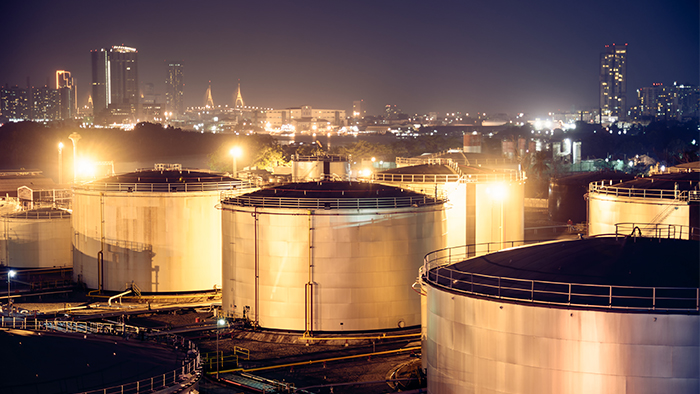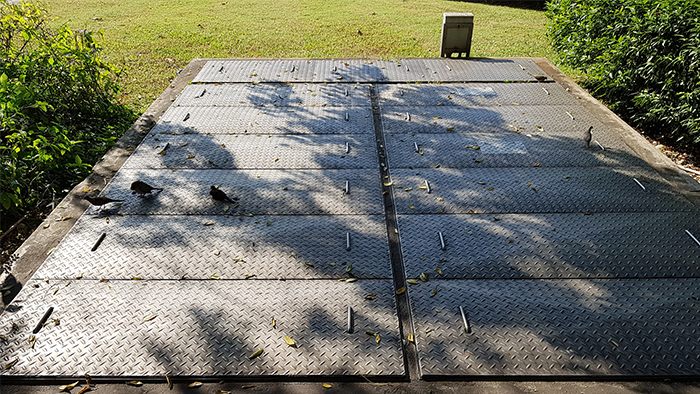Storage Tanks
This area covers regulations for environmental management of aboveground and underground storage tanks. Aboveground storage tanks (ASTs) and underground storage tanks (USTs) are subject to regulation at the federal, state, and local levels. Whether your tank is considered an AST or UST depends on the regulations in your jurisdiction. A tank need not be completely underground to be regulated as a UST. For example, the U.S. Environmental Protection Agency (EPA) defines a UST system as “a tank and any underground piping connected to the tank that has at least 10 percent of its combined volume underground.” Environmental regulations for storage tanks cover areas such as the design, construction, installation, general operation, fees, and closure, as well as Spill Prevention, Control, and Countermeasure (SPCC) Plan requirements. Other requirements for storage tanks may include remediation, release response, corrective action measures, financial responsibility, and liability requirements.
Most ASTs and USTs at retail facilities are used to store petroleum products, for example, at gas stations, or for emergency generators. This area is focused on tanks storing petroleum products. Additional regulations apply to tanks storing hazardous substances and hazardous wastes.
Compliance Considerations
Storage tanks are regulated at the federal, state and local levels. Federal regulations primarily concern SPCC planning and the installation, operation, closure, and remediation of USTs. State and local regulations may have more stringent requirements and may require permitting or registration of ASTs and USTs.
Spill Prevention, Control, and Countermeasure (SPCC) Plans
Section 311 of the Clean Water Act (CWA) authorized EPA to establish a program to prevent oil spills that may occur in navigable waters of the U.S. Under the CWA, “navigable waters” has been broadly defined to include waters such as streams or wetlands that connect to larger bodies of water. The program includes regulations for SPCC planning under 40 CFR Part 112. The purpose of SPCC planning is to prevent, prepare for, and respond to oil discharges to or with the potential to reach water bodies. Facilities that store oil above certain threshold quantities, with a reasonable expectation that a spill or leak could discharge oil into or upon navigable waters or adjoining shorelines, must have an SPCC plan.
Retail facilities are subject to EPA’s SPCC planning requirements if their onsite aggregate aboveground storage capacity of oil is greater than 1,320 gallons or their completely buried storage capacity is greater than 42,000 gallons. In addition to petroleum-based oils, the SPCC planning covers any material that can act like oil in water, including the dielectric mineral oil in transformers, hydraulic oils such as those in elevator reservoirs, and animal or plant oils such as those used in deep fryers.
To determine the aggregate oil storage capacity (i.e.,not the amount of oil stored but the amount that could be stored) at your facility, count all oil storage tanks, drums and other containers with a capacity of 55 gallons or greater. However, there are some exceptions that do not have to be included in the count, including:
- Permanently closed containers are usually exempt.
- “Completely buried storage tanks” that are regulated under EPA’s UST program (40 CFR Part 280) or a state-approved UST program (40 CFR Part 281) are exempt. For example, completely buried storage tanks that contain gasoline or diesel for resale to consumers would not have to be counted because these tanks are regulated under EPA’s UST program.
- Some USTs do have to be counted as they are excluded from the definition of a “UST” or are deferred from some UST regulatory requirements. For example, completely buried storage tanks that hold “heating oil for consumptive use on the premises where stored” are excluded from the definition of a UST and therefore, need to be counted towards the total storage capacity for SPCC planning requirements.
When determining if the facility could reasonably discharge oil into or upon navigable waters or adjoining shorelines, the location in relation to streams, ponds, ditches (perennial or intermittent), storm or sanitary sewers, wetlands, mudflats, sandflats, or farm tile drains must be considered. Any oil that has the potential to discharge into a storm or sanitary sewer drain would be sufficient to reach a determination that a discharge is reasonably likely even if a water body is not nearby.
SPCC planning requirements are focused on tank design, secondary containment of bulk oil storage tanks and containers, routine oil handling procedures, integrity testing and periodic inspections, spill response procedures, and personnel training. Periodic inspections and testing are required to assess the integrity of bulk storage tanks or containers with inspection and test records kept with the plan for at least three years. Generally, SPCC Plans must be certified by a professional engineer. However, retailers with 10,000 gallons or less of total aboveground oil storage and no individual aboveground oil containers greater than 5,000 gallons may qualify as Tier 1 qualified facilities and can self-certify their SPCC plan without a professional engineer. EPA’s Oil Spills Prevention and Preparedness Regulations website has more information.
A discharge of oil to navigable waters or adjoining shorelines must be immediately reported to the National Response Center (NRC) at 1-800-424-8802 when the discharge:
- Causes a sheen or discoloration on the surface of the water or adjoining shoreline;
- Causes a sludge or emulsion below the surface of the water or on the adjoining shoreline; or
- Violates an applicable water quality standard.
- More than 1,000 gallons of oil in a single discharge to navigable waters or adjoining shorelines (which, as described above, could be a storm drain); or
- More than 42 gallons of oil in each of two discharges to navigable waters or the adjoining shorelines within any twelve-month period.
Spill Reporting Matrix
View MatrixAboveground Storage Tanks (ASTs)
The primary federal regulations addressing petroleum containing ASTs are the SPCC Rule described above and the Occupational Safety and Health Administration (OSHA) regulations at 29 CFR Section 1910.106. Most states have AST registration, design, installation, operation, and/or permitting requirements. For example, some states have additional requirements for sizing secondary containment, such as a certain number of inches or a one hundred year storm level. ASTs containing used or waste oil may also need to be managed within the SPCC plan, but containers may need to be labeled according to state rules.

For installation considerations, local fire codes often limit tank capacity, and require minimum tank separation from buildable property lines, buildings, public ways, dispensers, and other ASTs. Information on fire-resistant/protected tanks can be found at UL 2085 and UL 142. Check state and local regulations, including standards or regulations issued by the fire marshal, for AST requirements.
EPA recommends that all AST systems have some form of corrosion protection for the tank. Options include elevating tanks so they are not in contact with the ground, resting tanks on continuous concrete slabs, installing double-walled tanks, cathodically protecting the tanks, internally lining tanks, inspecting tanks (this is also required under the SPCC planning requirements), or a combination of the options listed above. EPA also recommends that all underground piping to the tank should be either cathodically protected or double-walled with an interstitial leak detection system. To maximize tank system safety, the floors, containment area, and sump pump pit should be sealed with an appropriate coating (e.g., petroleum resistant coating). Any accumulated water should be inspected for petroleum or chemicals prior to discharge.
Underground Storage Tanks (USTs)

EPA regulations for USTs under 40 CFR Part 280 specify minimum requirements for design, installation, operation, maintenance, monitoring, and closure of USTs. In addition, federal UST requirements include provisions for release detection, reporting, response and corrective action, and financial responsibility in case of spills, overfills, and release. EPA's website has additional UST information.
Generally, new and replaced USTs must:
- Have a double-walled tank (i.e., secondary containment) with interstitial leak monitoring;
- Have double-walled piping (i.e., secondary containment) with interstitial leak monitoring, unless the piping is a safe suction system;
- Be protected against corrosion (both tank and piping through use of a non-corrodible material, a cathodic protection system, or siting);
- Be equipped with spill prevention equipment; and
- Be equipped with overfill protection equipment (e.g. automatic flow shut off device or high-level alarm).
UST installation involves correctly siting, excavating, assembling, backfilling, and grading the surface. Proper UST installation must be done according to a code of practice developed by a nationally recognized association or an independent test laboratory and according to the manufacturer’s instructions. When a new UST is brought into use, the owner must submit an UST notification form to their implementing agency within 30 days that certifies that the installation meets applicable requirements. Within 30 days of assuming ownership of a regulated UST, owners must submit a notification of ownership change to their implementing agency.
UST equipment including leak detection and cathodic protection systems must be properly operated and maintained. You must use an approved leak detection method (generally, at least once every 30 days) to show that no petroleum has been released from the UST system’s tank or piping. The appropriate leak detection method, or combination of methods, will vary based on the system’s installation date and type. EPA has information on leak detection methods to help users determine the appropriate method or methods. Leak detection equipment must be annually tested for proper operation. Failed leak detection monitoring results systems can result in fines or penalties for noncompliance, and possibly an expensive cleanup.
Proper corrosion protection needs to be maintained to continuously provide corrosion protection. All cathodic protection systems must be tested every three years for proper operation with additional routine inspections required for impressed current cathodic protection systems.
In addition to the maintenance activities described above, walkthrough inspections of UST systems are also required. Generally, the walkthrough inspection must occur once every 30 days to check spill prevention and leak detection equipment with an annual inspection of any containment sumps and hand-held leak detection equipment.
USTs taken out of service, either temporarily or permanently, are subject to detailed requirements for closure.
Under 40 CFR Part 281, states may receive approval from EPA to implement their own UST programs in lieu of the federal regulations. EPA maintains a list of states with approved UST programs. Owners and operators in states that do not have EPA approval for their UST programs need to follow both their state and federal requirements. State UST programs can be broader in scope and have more stringent requirements.
UST Operator Training Requirements
Under federal UST regulations, Class A, Class B, and Class C operators must be designated and trained, and owners and operators of UST systems must maintain records verifying that training has been completed. The three operator class descriptions are:
- Class A operators have primary responsibility to operate and maintain the UST system. For a typical gas station, this is the owner of the station or his designee. For large corporations, this is the manager or designee responsible for tank operations. The class A operator can also be designated as a Class B operator as long as they have passed the Class B operator exam.
- Class B operators implement day-to-day aspects of operating, maintaining, and recordkeeping for UST systems. For a typical gas station, it is the owner or the person/company contracted by the owner to maintain the tanks. For large corporations, it is the employee, or person/company contracted by the corporation to maintain the tanks. A broad knowledge base is required for a Class A operator, while the Class B operator must have in-depth knowledge of tank system operation and maintenance.
- Class C operators are the employees responsible for responding to alarms or other indications of emergencies caused by spills, releases, or overfills associated with an UST system. For a typical gas station, this is the cashier. Though an exam is not required, this person must be trained in responding to releases, alarms, and emergency conditions. Training can be performed by the Class A operators, Class B operators, or third-party vendors.
The EPA’s regulations allow states the flexibility to establish their own state training requirements, so long as the operator training program meets the minimum federal standards.
Sustainability and Reducing Compliance Risk
Spill prevention is critical to overall sustainability as petroleum can degrade habitat by causing water and soil contamination. A good tank management program and compliance with environmental regulations can significantly reduce the potential for spills and will expedite response and resolution measures if a spill occurs Compliance obligations can be reduced by right-sizing tanks or reducing the amount of petroleum stored in tanks or the number of tanks at your facility. Staying below reporting thresholds or SPCC plan thresholds can save effort and reduce regulatory requirements.
Tags
-
Storage Tanks



